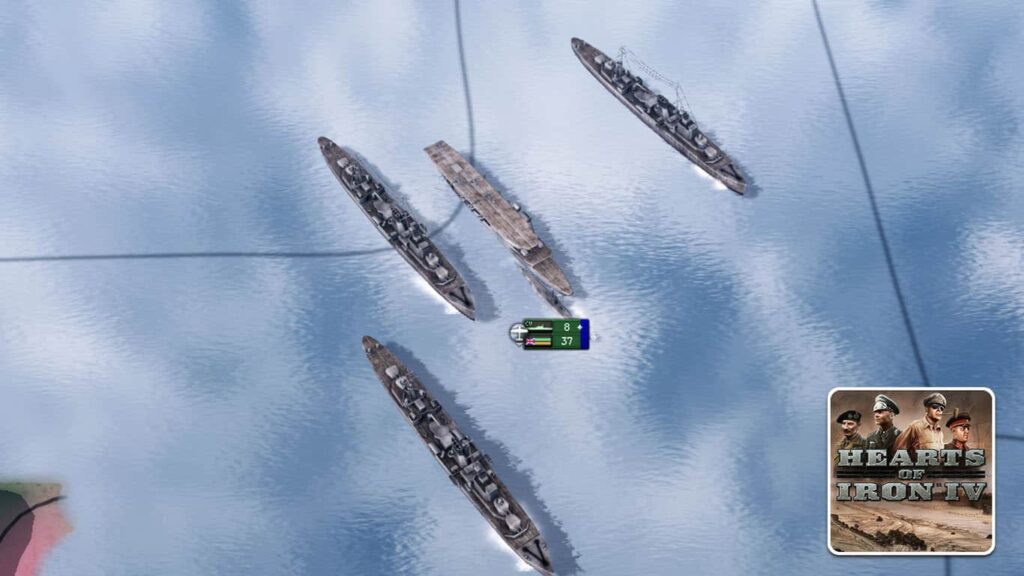One of the most impactful ships in the Second World War were the Carriers. These giant floating islands work as a landing and take-off point for planes, which can move around on the sea, allowing them to perform effective missions in enemy territories.
Carriers are the bread and butter of the United States since they can’t really use their planes on the Pacific front otherwise.
Recommended Read: How to Increase Supply in HOI4
They are also vital for naval-focused countries like the United Kingdom and Japan for their continuous use of naval invasions.
These ships are also very important in naval battles since they allow the powerful bombers that deploy off of them to deal massive damage to enemy fleets.
To put planes on Carriers in Hearts of Iron 4, you need to leave them out of combat manually where you want them to. Then, you can deploy your planes on them, as you would on any normal airfield.
Table of Contents
How to Put Planes on Carriers in HOI4
You can’t just throw any plane on a carrier! You must first research the land-based version of an aircraft. Then, you’ll need to research the carrier-capable versions of Fighters, Close Air Support, and Naval Bombers.
These variants have different names, stats, and artwork compared to their land-based counterparts. You’ll find the research option by clicking the aircraft carrier button on the aircraft type in the air research tab.
When you build a new carrier, it comes with a pre-assembled air wing produced during construction using your dockyards.
This air wing will be equipped with the most up-to-date carrier-capable models you’ve researched. Before launching the carrier, you can adjust the types of planes included in its air wing to fit your strategy.
When your carrier joins a patrolling fleet, its air wing automatically transforms into a Carrier Air Group. This Carrier Air Group automatically engages in any naval combat your fleet encounters.
How Carriers Work and How to Use Them
Carriers can do two things in HOI4:
- Carriers act as floating air bases for carrier-capable aircraft (fighters, CAS, and naval bombers). These planes can be launched for various missions outside of combat.
- During combat, carriers deploy their aircraft as a Carrier Air Group, automatically engaging enemy fleets. They don’t require the usual 8-hour wait to join the fight.
Carriers function as mobile airfields. The number of planes they can carry depends on the available hangar space. This allows for incredible strategic flexibility. You can equip your carriers with:
- Naval Bombers: Deliver devastating blows to enemy fleets, particularly effective against capital ships.
- Fighters: Provide crucial air defense against enemy carrier aircraft, safeguarding your fleet from aerial assaults.
- Close Air Support (CAS): Offer offensive support for land forces during amphibious assaults or naval invasions. By strategically positioning your carriers near the invasion zone, you can provide crucial air cover for your landing troops.
How to Design a Carrier
The design of the Carrier can be very important, since this allows you to get the most out of this huge, heavy ship.
Carriers are very vulnerable, so focus on maximizing their hangar space to carry more planes. Heavy armor is a waste. Rely on your escorts for protection. If your frontline screen is gone, your carriers are likely doomed anyway.
Match your carrier’s engine speed to your fleet’s overall speed. Carriers are often faster than battleships. Secondary weapons are a personal choice, offering some light attack against destroyers.
Tips on How to Use Them
- Before engaging enemy fleets, consider swapping any carrier CAS for naval bombers. This maximizes your damage output.
- Strive for a balance between offense and defense. A common strategy is using 1 fighter for every 5 naval bombers. Fighters protect against enemy carrier aircraft, while bombers deal heavy damage with their piercing attacks.
- Carriers are vulnerable once their escorts are destroyed.
- Unlike land-based aircraft, carrier wings can be trained and require micromanagement for optimal performance.
That’s everything you need to know about how to put planes on carriers in Hearts of Iron 4!
Have any input or suggestions for this guide? Let us know in the comment section below.




This is a great overview of an important aspect of HOI4. Understanding how to effectively use carriers can really enhance gameplay.
Absolutely! Mastering carrier tactics can really change the tide of battles in HOI4. Also, combining air and naval strategies can create powerful synergy, allowing for more effective control of the seas.
I totally agree! Combining air and naval strategies can create a powerful synergy in HOI4. It’s interesting how different aircraft types can complement each other on carriers, enhancing overall effectiveness in various scenarios.
Absolutely! The combination of air and naval strategies really changes the game dynamics. Plus, using carriers effectively can also help protect your naval units from enemy air attacks, adding another layer of strategy. It’s fascinating how each decision can influence the overall outcome!
You’re right about the synergy between air and naval strategies! It’s fascinating how mastering carrier operations can really turn the tide in battles. Properly managing your aircraft can provide crucial support for ground troops too, making it a key aspect of overall military strategy.
Absolutely, the interplay between air and naval power really shaped the outcomes of many battles. It’s interesting to see how different nations approached carrier design and tactics, reflecting their unique military philosophies. Mastering carriers in HOI4 can definitely change the course of your campaign!
You’re right! The synergy between air and naval forces was crucial, especially in the Pacific Theater. It’s fascinating how carrier-based operations changed naval warfare strategies, making aircraft carriers a central asset in fleet engagements.
Absolutely! The ability to launch air strikes from carriers often determined the outcome of battles. It’s fascinating how strategies evolved to maximize that synergy, especially with the introduction of new aircraft technologies during the war.
You’re right! The versatility of carriers really changed naval warfare. It’s interesting to see how different strategies emerged, especially with the coordination between air and sea forces.
the introduction of aircraft on carriers allowed for strategic flexibility, enabling nations to project power far beyond their shores. It’s fascinating how this shift influenced not just naval battles, but also the overall tactics of war during that era.
Absolutely, the ability to launch air strikes from carriers revolutionized naval warfare. It also meant that nations could engage enemies from greater distances, changing the dynamics of battles significantly. This innovation really shifted the focus from traditional battleships to air power at sea.
You’re right! The strategic advantage of carriers really changed the dynamics of battles at sea. Plus, integrating air power with naval forces allowed for more versatile operations, which is something that HOI4 captures quite well.
Absolutely! The ability of carriers to launch air strikes from a distance was a game changer. It also meant that naval battles often hinged on air superiority, which added a whole new layer to strategy in HOI4.
I completely agree! The strategic advantage of carriers really reshaped naval warfare. It’s interesting how HOI4 captures that dynamic, allowing players to experiment with different tactics and formations to maximize their carrier’s potential.
Absolutely! Carriers not only changed naval tactics but also influenced air power strategies, allowing countries to project force far beyond their shores. It’s fascinating to see how they continue to play a pivotal role in modern naval operations as well.
That’s a great point! Carriers really did revolutionize both naval and aerial warfare. Their ability to project air power far from land changed the dynamics of many battles, making them essential for modern military operations.
Absolutely! Carriers not only changed the dynamics of battles at sea, but they also allowed for greater flexibility in deploying air power. This shift enabled nations to project force over longer distances, which was a game changer during the war.
You’re right! The introduction of carriers really revolutionized naval strategies. It’s fascinating how they enabled nations to project power far beyond their coastlines, reshaping warfare in ways we’re still studying today.